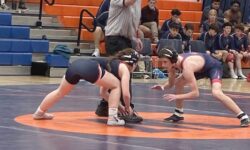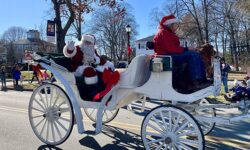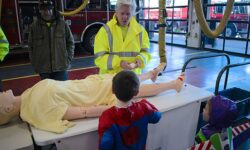By James Kinneen
Hometown Weekly Reporter
When schools across Massachusetts were deciding how they were going to handle their athletics, most, including Walpole, opted to move sports like football and indoor track to the new Fall II season. But while much of the media has focused on the uniqueness of football practice moving from the heat of late August to the chill of late February, the change provides indoor track with its own set of unique challenges and obstacles. Namely that ironically, indoor track won’t be indoors at all.
“We’re outdoors, so that’s a big difference,” Coach Corey Coogan explained when pressed on what would be most different about the season moving to Fall II. “We have to kind of reconfigure our outdoor track to meet the specifications for indoor track, since we have certain events that are usually geared towards a 200-meter length of track that we have to accommodate for a four-hundred-meter track. Also, since we’re competing outdoors, you still have snow on portions of the track, so we don’t even have a full track yet, which is definitely a challenge. Just being outdoors for the end of winter has definitely been the most difficult challenge.”
The Department of Public Works has cleared much of the snow, but the shade from the town forest has caused some issues with ice. But even on a clear track, for athletes, changing from indoors to outdoors provides its own unique range of issues, from altered breathing patterns to dealing with the wind.
“I would say it’s extremely different," Coogan answered when asked how different running track outside is versus running it inside. "Outside of the fact that we’re wearing masks this year, which is a challenge in itself, the distances are going to be very different. It’s a bigger track - an outdoor track is a four-hundred-meter track, and an indoor track is a 200-meter track - so it’s half the size and there’s usually a little bit of a bank to it. If athletes are used to running on an indoor track, which is obviously inside, the breathing is a lot different. The weather conditions will be different, there will be wind. But we’re outside, we’re practicing and starting to get used to the conditions, so now it’s just trying to get them into race shape.”
Part of the need for getting into race shape comes from spring track having been cancelled last season, meaning the team hasn’t raced in over a year. But even if athletes have been training on their own outdoors, are used to the weather and are in great shape, there’s another change they need to adjust to. If you thought moving outside meant the masks could come off, you’d be very wrong. While none of the events were cut, shot-puts need to be disinfected, but more importantly, runners need to wear masks in every race - although in long distance races, which tend to be further spread out, they can at least pull them down.
“They do have to start their race with masks, and the idea with most events is going to be to keep the mask on for the entirety of the race. As you get into the distance events, it’s a little bit different. I think as long as they have six feet of space, they can kind of pull those masks down, but they still need to be worn, even if they’re pulled down, and they have to be put back on as soon as the race is finished. There are some pretty strict guidelines, but obviously it’s warranted.”
Currently the team is practicing for what will be between four and six meets in “pods,” which are essentially smaller groups of athletes that compete in the same types of events (for example: long distance, sprinting, throwing). But another issue the move to Fall II created for the athletes was forcing some of them to choose between two sports they usually play within the same year (for example football and track), as well as force spring athletes to decide if they’d be better off running track or training for the upcoming season. As a result of this, combined with some pandemic related issues, the team’s number of participants dropped significantly.
“The pandemic definitely hit us pretty hard. Going into spring last year, before it got cancelled, we were looking at 120 athletes that signed up - which would have been the biggest numbers we’ve had in the nine years I’ve been here - and this year, we’re down to about fifty. It’s a mixture of us losing some guys to football; some guys decided not to come out; for some guys, lacrosse is their main sport, and since we’re getting so close to lacrosse season, they opted to play a club sport instead of doing this shortened indoor track season. We do indoor track at the Reginald Lewis Center, which is a beautiful facility; professionals compete there. So, doing indoor on an outdoor track is probably part of the reason why our numbers aren’t as big. I think the long layoff had a lot to do with the numbers being down, also; the fact that we’re not allowed to have big gatherings within the school to get the word out as easily as we used to. It’s probably going to take a couple of years for those numbers to recover.”
Despite the myriad obstacles, Coach Coogan believes if his team performs well, they should be able to win four of the possible six meets. While dealing with a pandemic is new, the team also finds itself in the classic high school athletics dilemma of having to replace a bunch of seniors that graduated last year. To accomplish this, the team is going to lean on their current seniors in an extremely unusual season.
“It’s been a while, but some of our returners had a lot of success in previous years. We have a hurdler that’s a senior this year named Dallin Byerly, who is a captain. He’s looking forward to a great season. He’s been a standout athlete for us since his sophomore year, and he’s looking forward to just being back on the track after a long layoff. We have another senior captain, a sprinter named Ben Skypeck, who was a standout for us last indoor season, so we’re looking forward to having him competing. Those are definitely our two standout guys, but we’ve got a senior named Will Connors in the high jump who really came on for us last year. It’s just big to get some of these guys back out there, and back competing after a long time off.”
Coogan acknowledged that with those seniors also competing in spring track, the start of which will be very close to the end of indoor track, that proximity will also come into consideration in their training. But overall, despite the issues the team is dealing with, the overall mood is an excited one - if for no other reason than to get back on the track for the first time in over a year.
“We’re excited to be back. We’re a program that’s continuing to grow and we’re just excited to get back out there and get back to competing. It’s been a long layoff, it’s been tough for a lot of us, and it’s just good to get the athletes back out there competing and having fun; doing things they enjoy doing along with their studies. It’s really nice to get the student athlete piece back in full swing.”





















